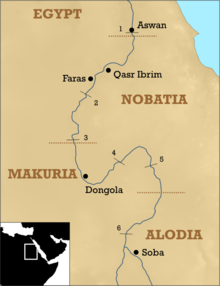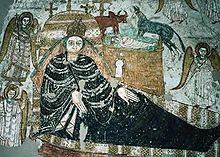Makuria
Makuria (also Makurien in German) ( Arabic مقرة, DMG al-Muqurra ; also written al-Mukurra ) was a Christian state in Nubia , in what is now northern Sudan , from the 4th century to the 14th century .
After the fall of the Meroitic Empire, three successor states seem to have developed (from north to south: Nobatia , Makuria and Alwa ), which at first were still very much in the tradition of the Meroitic Empire. At the end of the 6th century these states, including Makuria, converted to Christianity . For the time around the year 568, Johannes von Biclaro reports that the empire had become Christian. In 573 a delegation with gifts from Emperor Justin II reached the capital of Makuria and confirmed friendship with the Byzantine Empire. Around this time the kingdom of Nobatia was united with Makuria, whether this was done peacefully or militarily is unknown. Christianity was brought to Nubia by missionaries from the Byzantine Empire . Christianity in Nubia, but also the Nubian state and its administration and art are therefore strongly influenced by Byzantium.
The capital of Makuria was Alt Dunqula , about 100 km south of the 3rd Nile cataract . The city does not seem to have played a special role in Meroitic times, but apparently it was founded as a fortress shortly after the fall of the Meroitic Empire and quickly developed into a city. In Christian times, Old Dunqula is described by Arabic writers as magnificent. Excavations have unearthed numerous important buildings, including many churches and a large monastery.
swell
Makuria was in constant conflict with Muslim Egypt and the fortunes of the country, as far as military conflicts are concerned, are therefore relatively well known from Arab writers. The Arabic sources are still not reliable. It is often difficult to identify certain king names, different sources contradict each other and above all Makuria appears as an opponent and is therefore not always presented in the best light. Besides, we learn little of events in peacetime.
In addition to the Arabic sources, Byzantine sources play a certain role, especially for the early days of the Christian empires and Christianity in particular.
Archaeological excavations have produced rich material on the culture of Makuria, with Lower Nubia, Old Dunqula and Banganarti being very well researched, while many questions remain unanswered about other locations. There are numerous texts that are written in Old Nubian , Greek, but also in Coptic. In terms of dating, they follow the Diocletian's era, which is also common in the Coptic area .
expansion
With the help of Arabic writers and archaeological sources it is possible to get some idea of the extent of Makuria. Accordingly, the northernmost city (after the incorporation of the area of Nobatia, previously the northern border was near the 3rd Nile cataract) was el-Qasr , just 8 km south of Aswan . Upstream of the Nile, the border was probably between the 4th and 5th Nile Cataracts, where the Kingdom of Alwa joined. The concrete expansion to the east is still unclear. West of the Nile Makuria was present but certainly: The Arab historian Ibn Hawqal claims that Makuria a province west of the ( white !) Nils commanded by the name of "Al-Jeblien" what probably on Nordkordofan relates. A graffito from Nordkordofan that mentions a Makurian king of the 1330s is further evidence. Recently, a monastery in Gebel al-Ain , more than 200 km from the Nile, was also described. Local traditions still remember today that Kordofan was once a province of the Christian kingdom of Mubiyya . Large parts of Kordofans were Nubian-speaking until the 19th century.
history
In 640 Egypt was conquered by the Arabs . The Byzantine governor of Egypt, Aristulis, had asked the Nubians and Bedjah for help against the advancing Arabs, but did not get it. As early as 642, an Arab troop of 20,000 soldiers under the leadership of ʿAbd Allah ibn Saʿd ibn Abī Sarh moved to Nubia to conquer this country as well. The course of the campaign is not known in detail, but the Nubians were able to defeat the Arabs and in 652 a peace treaty was negotiated. After that, the Nubians had to pay a tribute (baqt) to the Arabs every year:
- 365 slaves to the treasurer of the Muslims
- 40 slaves to the Emir of Egypt
- 26 more slaves
- Fabrics, cereals and other natural products
This ensured Makuria's independence, although most of the disagreements between the two states in the centuries that followed were based precisely on these tributes. There are repeated reports of Egyptian campaigns, but they were always unsuccessful.
The following centuries can be described as the Golden Age of Makuria. Large churches were built throughout the empire, most of which were colorfully painted with Christian scenes. Numerous monasteries and fortresses were built to secure the empire. Numerous inscriptions show that a high proportion of the population was literate. Greek , Coptic and Old Nubian (written with a variant of Coptic) were the written languages.
Little is known about the history of this period. For the year 748 it is reported that King Cyriacus invaded Egypt because the Egyptians had imprisoned the Patriarch of Alexandria . Cyriacus demanded his release, and when this did not happen, the ruler is said to have marched with an army as far as Cairo . The prisoner was released and the Nubians withdrew. During this period Egypt was partially torn by civil wars and large parts of Upper Egypt were still Christian, so that little hostility was to be expected from this side. From the 9th century, however, there are reports of military friction between Makuria and its northern neighbor. In 950 even the oases were plundered. Aswan has been the target of raids several times.
It was not until the 13th and 14th centuries that Muslim attacks became stronger and stronger and the Mamluks more than once put a king on the throne of Makuria that they liked. This constant friction finally led to the abandonment of the capital Alt Dunqula in 1365 . The shift in trade routes and the Black Death in the 14th century may also have played a role. In any case, Makuria disappears from historical sources, but it seems to have lived on in the kingdom of Dotawo until around 1500.
The king
The kingship is described mainly by Arabic sources. The king was the unrestricted ruler over his subjects and he was probably also the owner of all land. Although all known kings are men, it is clear from various sources that the line of succession was governed by the female line. It was always the king's sister whose son succeeded him. Only if this had no sons were other family members of the king or even completely different people appointed as successors. The king was called Kasil , Kamil or Kabil . One king of Makuria even calls himself Augustus .
The kingship appears to have had close ties to the kingdom of Alwa . It is attested several times that a king of Makuria also ruled over Alwa. There is also evidence that the families of both royal houses were connected by marriage.
The kings of Makuria wore crowns with a tiara and a cross. These crowns are said to have been made of gold and were richly decorated with colored stones according to wall paintings. Some rulers were depicted with some kind of purse. In other African empires this symbolizes his power over the subjects.
administration

Little is known about the administration of the Makuria Empire. Some sources seem to suggest that there were vassal kings. There are said to have been thirteen of them under Cyriacus . Little is known of these. From Gebel Adda , a mountain south of the 1st cataract and capital of the kingdom of Dotawo , there is a short inscription that names a king Taanengo , who is otherwise unknown and could have been a vassal king.
In addition to the king of Makuria, there are some high officials who ran the affairs of state. The most important was the eparch , an official title which, like other names, was adopted from the Byzantine administration. The eparch was a kind of viceroy of Nobatia , but also seems to have taken care of matters such as the trade that affected the Muslims and Makuria. He had his residence in Faras , temporarily in Qasr Ibrim , but also in other places. In addition to the Eparchen there were other important officials whose function is often not clear, such as a primicerius and a Protodomesticos , who was probably familiar with the administration of the palace.
economy
Agriculture was the economic basis of the Nubian state of Makuria. In the Egyptian Nile Valley, the arable land to the left and right of the Nile is relatively wide. South of the 1st Nile Cataract, on the other hand, there is rarely a comparable potential of arable land. All important places are in areas in which there is a little more arable land and where therefore a larger population could be fed. At the latest in Christian era were in Nubia Saqia ( waterwheels introduced), which turned from a bovine, could carry large amounts of water to higher-lying country and made so larger areas available.
It is known from Arab authors that palms , vines , bananas , cereals and lemons were grown. In addition, were sheep , goats , cattle and pigs kept. Camels were used for riding. Fishing was another important source of food.

Important branches of trade were pottery and probably also fabric production.
Trade is attested almost exclusively with Egypt in the north, but this may also be an archaeological gap, as there are only a few archaeological sites in the rest of Africa. Numerous goods were imported to Makuria, above all there were potteries near Aswan which also supplied Lower Nubia with ceramics. Slaves, gold and natural products are mentioned as export goods.
A monetary currency was never introduced in Makuria. Barter remained predominant.
See also
Individual evidence
- ^ Spaulding 1998, p. 49
- ↑ Ochala 2011, p. 154
- ↑ Jana Eger: A medieval monastery on the Gebel al-Ain? In: MittSAG 22, 2011, pp. 115–120 ( PDF ).
- ↑ Hesse 2002, p. 23
- ↑ Hesse 2002, p. 21
- ^ Derek A. Welsby: The Mediaval Kingdoms of Nubia , p. 77
- ↑ Wolfram Grajetzki : The end of the Christian-Nubian empires: In: Martin Fitzenreiter (Ed.): The event. Writing history between incident and finding. London 2009, pp. 117-124, ISBN 978-1-906137-13-7
literature
- François-Xavier Fauvelle: The golden rhinoceros. Africa in the Middle Ages. CH Beck, Munich 2017.
- Gerhards Hesse (2002): The Jallaba and the Nuba Nordkordofans. Trader, Social Distinction and Sudanization. Lit. ISBN 3825858901 .
- Grzegorz Ochala (2011): A King of Makuria in Kordofan . In Adam Lajtar, Jacques van der Vliet. Nubian Voices. Studies in Christian Nubian Culture. Journal of Juristic Papyrology. pp. 149-156. ISBN 9004110496 .
- Wilfried Seipel (Ed.): Faras. The cathedral from the desert sand . Vienna 2002, ISBN 3-85497-042-0 (Introduction with the history of Nubia in the Middle Ages)
- Jay Spaulding (1998): Early Kordofan . In Endre Stiansen and Michael Kevane. Kordofan Invaded: Peripheral Incorporation in Islamic Africa. Brill. pp. 46-59. ISBN 9004110496 .
- Derek A. Welsby : The Medieval Kingdoms of Nubia. Pagans, Christians and Muslims on the Middle Nile. British Museum Press, London 2002, ISBN 0-7141-1947-4 . (introductory work on Christian Nubia with a focus on archeology)
- Roland Werner : Christianity in Nubia. History and shape of an African church . Lit. Berlin. 2013. ISBN 9783643121967 . (detailed overview of the history and Christian culture)




